I haven't provided detailed commentary on the US labour market for a while now. To…
US labour market is a sort of holding pattern – declining but slowly
Last Friday (December 2, 2022), the US Bureau of Labor Statistics (BLS) released their latest labour market data – Employment Situation Summary – November 2022 – which suggested that the US labour market showed signs of slowing further, with payroll employment growing by just 263,000 net jobs. The labour force measure showed employment and labour force growth turning negative as the participation edged down. The result was that the official unemployment rate remained largely unchanged – with both the demand and supply side falling in proportion. The quit rate is stable which suggests that the US labour market is in a sort of holding pattern – slowing weakening but not consistent with the Federal Reserve type narratives. There are also no fundamental wage pressures emerging at present to drive any further inflation spikes. Wages growth appears to be reactive to inflation rather than propelling it. Wages growth appears to be reactive to inflation rather than propelling it. The claim that wage pressures are now pushing inflation is untenable given the data.
Overview for November 2022 (seasonally adjusted):
- Payroll employment increased by 263,000 – almost identical to last month.
- Total labour force survey employment fell by 138 thousand net (-0.11 per cent).
- The labour force fell by 186 thousand net (0.11 per cent).
- The employment-population ratio fell 0.1 point 59.9 per cent (now well below the May 2020 peak of 61.2).
- Total measured unemployment fell by 48 thousand to 6,011 thousand.
- The official unemployment rate was unchanged at 3.7 per cent.
- The participation rate fell by 1 point to 62.1 per cent.
- The broad labour underutilisation measure (U6) fell by 0.1 point to 6.7 per cent.
For those who are confused about the difference between the payroll (establishment) data and the household survey data you should read this blog post – US labour market is in a deplorable state – where I explain the differences in detail.
Some months the difference is small, while other months, the difference is larger.
The differences were quite large this month.
Payroll employment trends
The BLS noted that:
Total nonfarm payroll employment increased by 263,000 in November, roughly in line with average growth over the prior 3 months (+282,000).
Leisure and hospitality added 88,000 jobs in November … is below its pre-pandemic February 2020 level by 980,000, or 5.8 percent.
In November, employment in health care rose by 45,000 … So far in 2022, health care employment has increased by an average of 47,000 per month, well above the 2021 average monthly gain of 9,000.
Government added 42,000 jobs in November, mostly in local government (+32,000) … Since February 2020, government employment is down by 461,000, or 2.0 percent.
In November, employment in the other services industry rose by 24,000 … is below its February 2020 level by 186,000, or 3.1 percent.
Employment in social assistance increased by 23,000 in November and has returned to its February 2020 level …
Construction employment continued to trend up in November (+20,000) … Construction has added an average of 19,000 jobs per month thus far this year, little different from the 2021 average of 16,000 per month.
Employment in information rose by 19,000 in November … has increased by an average of 14,000 per month thus far this year, in line with the average of 16,000 per month in 2021.
Manufacturing employment continued to trend up in November (+14,000). Job growth has averaged 34,000 per month thus far this year, little different from the 2021 average of 30,000 per month.
In November, employment in financial activities continued its upward trend (+14,000) … has increased by an average of 12,000 per month thus far this year, the same as in 2021.
Employment in retail trade declined by 30,000 in November … has fallen by 62,000 since August.
Employment in transportation and warehousing declined by 15,000 in November and has decreased by 38,000 since July …
Monthly job growth in professional and business services has averaged 58,000 thus far in 2022, down from 94,000 per month in
2021.Employment showed little change over the month in mining and wholesale trade.
The first graph shows the monthly change in payroll employment (in thousands, expressed as a 3-month moving average to take out the monthly noise). The red lines are the annual averages. Observations between January 2020 and November 2020 were excluded as outliers.
The recovery since the pandemic job losses are not even across the sectors as detailed above.
The next graph shows the same data in a different way – in this case the graph shows the average net monthly change in payroll employment (actual) for the calendar years from 2005 to 2021.
The red marker on the column is the current month’s result.
The final average for 2019 was 164 thousand.
The final average for 2020 was -774 thousand.
The final average for 2021 was 562 thousand.
The average so far in 2022 is 392 thousand and falling fast.
Labour Force Survey data – employment declines for the second consecutive month
The seasonally-adjusted data for November 2022 reveals:
1. Total labour force survey employment fell by 138 thousand net (-0.11 per cent) – the second consecutive month.
2. The labour force declined by 186 thousand net (0.11 per cent).
3. The participation rate fell by 0.1 points to 62.1 per cent.
4. As a result (in accounting terms), total measured unemployment fell by 48 thousand to 6,011 thousand and the official unemployment rate was unchanged at 3.7 per cent (after rounding).
Taken together these results signal a labour market in slow decline.
The following graph shows the monthly employment growth since January 2008 and excludes the extreme observations (outliers) between May 2020 and November 2020, which distort the current period relative to the pre-pandemic period.
The Employment-Population ratio is a good measure of the strength of the labour market because the movements are relatively unambiguous because the denominator population is not particularly sensitive to the cycle (unlike the labour force).
The following graph shows the US Employment-Population from January 1950 to November 2022.
In November 2022, the ratio fell by 0.1 point 59.9 per cent.
The peak level in May 2020 before the pandemic was 61.1 per cent.
Unemployment and underutilisation trends
The BLS note that:
The unemployment rate was unchanged at 3.7 percent in November and has been in a narrow range of 3.5 percent to 3.7 percent since March …
The number of long-term unemployed (those jobless for 27 weeks or more) was little changed at 1.2 million in November. The long-term unemployed accounted for 20.6 percent of all unemployed persons. …
The number of persons employed part time for economic reasons was about unchanged at 3.7 million in November. These individuals, who would have preferred full-time employment, were working part time because their hours had been reduced or they were unable to find full-time jobs …
The reasons the unemployment rate rose in November were:
1. Employment growth was negative
2. The labour force contracted marginally as the participation rate edged down.
3. The contraction in employment was larger than the contraction in the labour force.
The first graph shows the official unemployment rate since January 1994.
The official unemployment rate is a narrow measure of labour wastage, which means that a strict comparison with the 1960s, for example, in terms of how tight the labour market, has to take into account broader measures of labour underutilisation.
The next graph shows the BLS measure U6, which is defined as:
Total unemployed, plus all marginally attached workers plus total employed part time for economic reasons, as a percent of all civilian labor force plus all marginally attached workers.
It is thus the broadest quantitative measure of labour underutilisation that the BLS publish.
Pre-COVID, U6 was at 6.8 per cent (December 2019).
In November 2022 the U6 measure was 6.7 per cent, an decrease of 0.1 point.
What are wages doing in the US?
With inflation rising sharply at present and the Federal Reserve pretending there is a major wage problem that needs to be disciplined with rising mass unemployment, one would expect to see strong nominal wages growth pushing the price level along.
The BLS reported that:
In November, average hourly earnings for all employees on private nonfarm payrolls rose by 18 cents, or 0.6 percent, to $32.82. Over the past 12 months, average hourly earnings have increased by 5.1 percent. In November, average hourly earnings of private-sector production and nonsupervisory employees rose by 19 cents, or 0.7 percent, to $28.10.
However, the latest – BLS Real Earnings Summary (published November 10, 2022) – tells us that:
Real average hourly earnings for all employees decreased 0.1 percent from September to October … This result stems from an
increase of 0.4 percent in average hourly earnings combined with an increase of 0.4 percent in the Consumer Price Index for All Urban Consumers (CPI-U) …Real average hourly earnings decreased 2.8 percent, seasonally adjusted, from October 2021 to October 2022.
The following graph shows annual growth in real average hourly earnings from 2008 to September 2022.
So there is some nominal wage catch-up going on but not sufficient to defend real wages nor drive the inflation episode further.
The other indicator that tells us whether the labour market is turning in favour of workers is the quit rate.
The most recent BLS data – Job Openings and Labor Turnover Summary (released November 30, 2022) – shows that:
… the number of hires and total separations changed little at 6.0 million and 5.7 million, respectively. Within separations, quits (4.0 million) and layoffs and discharges (1.4 million) changed little …
Quits are generally voluntary separations initiated by the employee. Therefore, the quits rate can serve as a measure of
workers’ willingness or ability to leave jobs …In October, the number and rate of quits were little changed at 4.0 million and 2.6 percent, respectively.
So the US labour market is in a holding pattern – slowly shedding jobs but not fast enough yet to drive the quit rate down.
Conclusion
In November 2022, the US labour market showed signs of slowing further, with payroll employment growing by just 263,000 net jobs.
The US labour market is in a sort of holding pattern – slowly shedding jobs but not fast enough yet to drive the quit rate down.
The slower conditions are keeping the participation rate down, which is helping keep the unemployment rate down.
It is a curious state.
There are also no fundamental wage pressures emerging at present to drive any further inflation spikes. Wages growth appears to be reactive to inflation rather than propelling it.
That is enough for today!
(c) Copyright 2022 William Mitchell. All Rights Reserved.
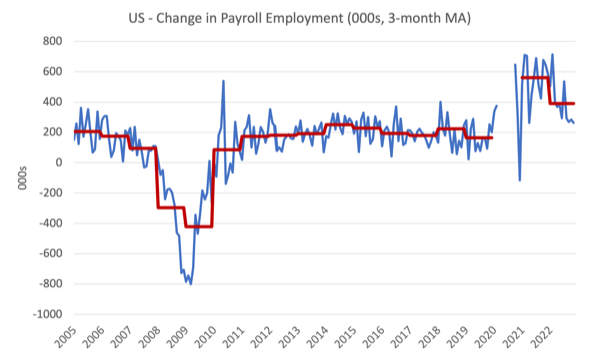
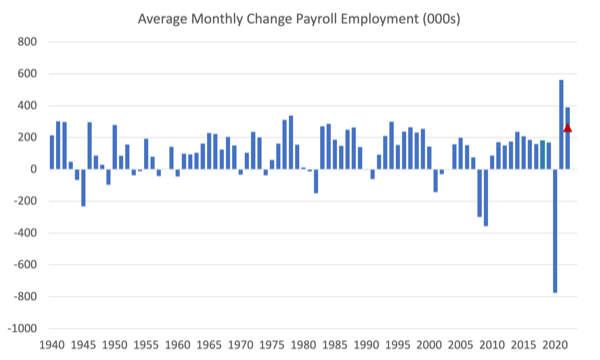
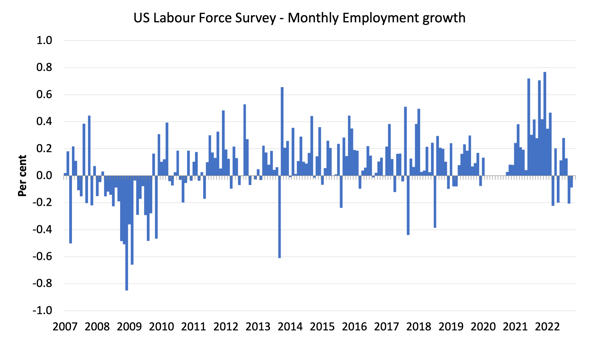
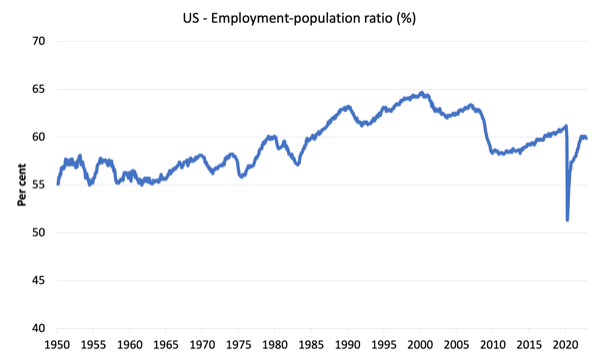
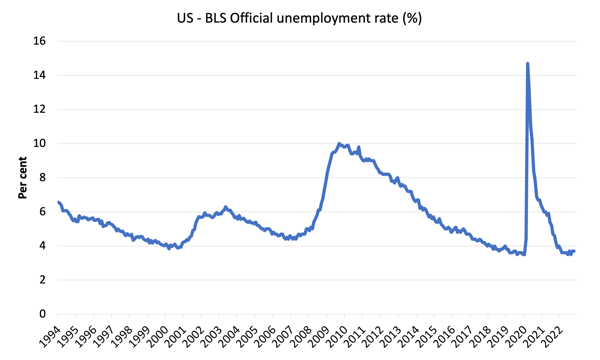
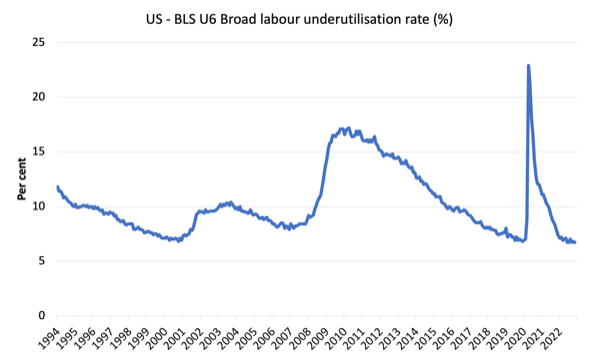

This Post Has 0 Comments